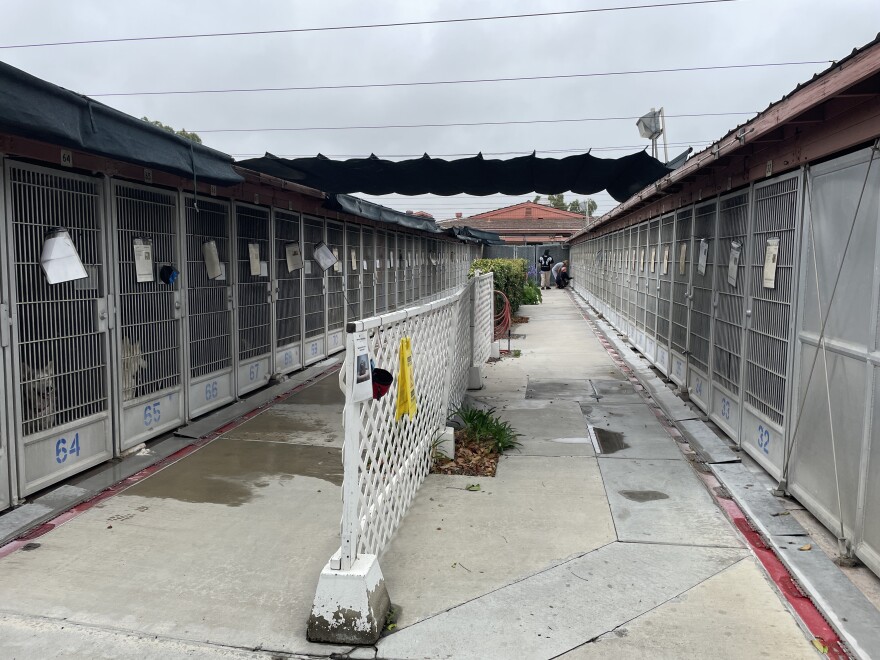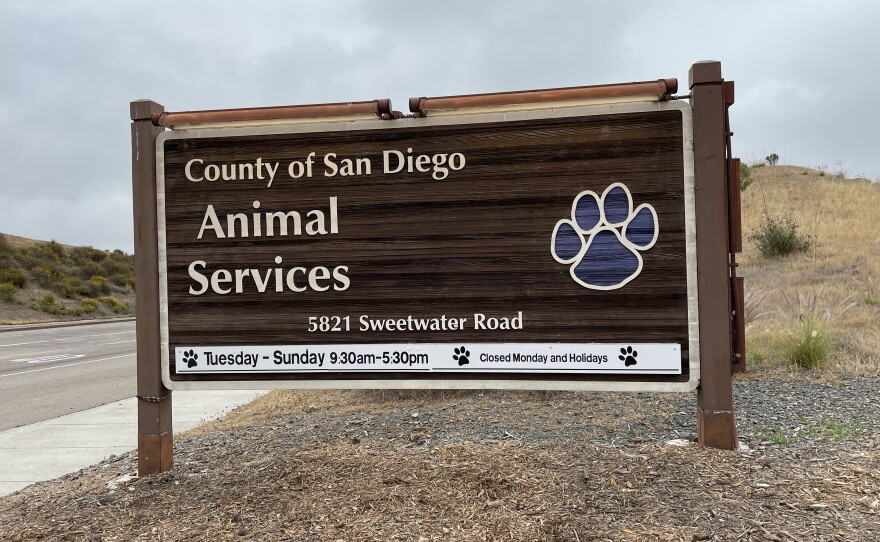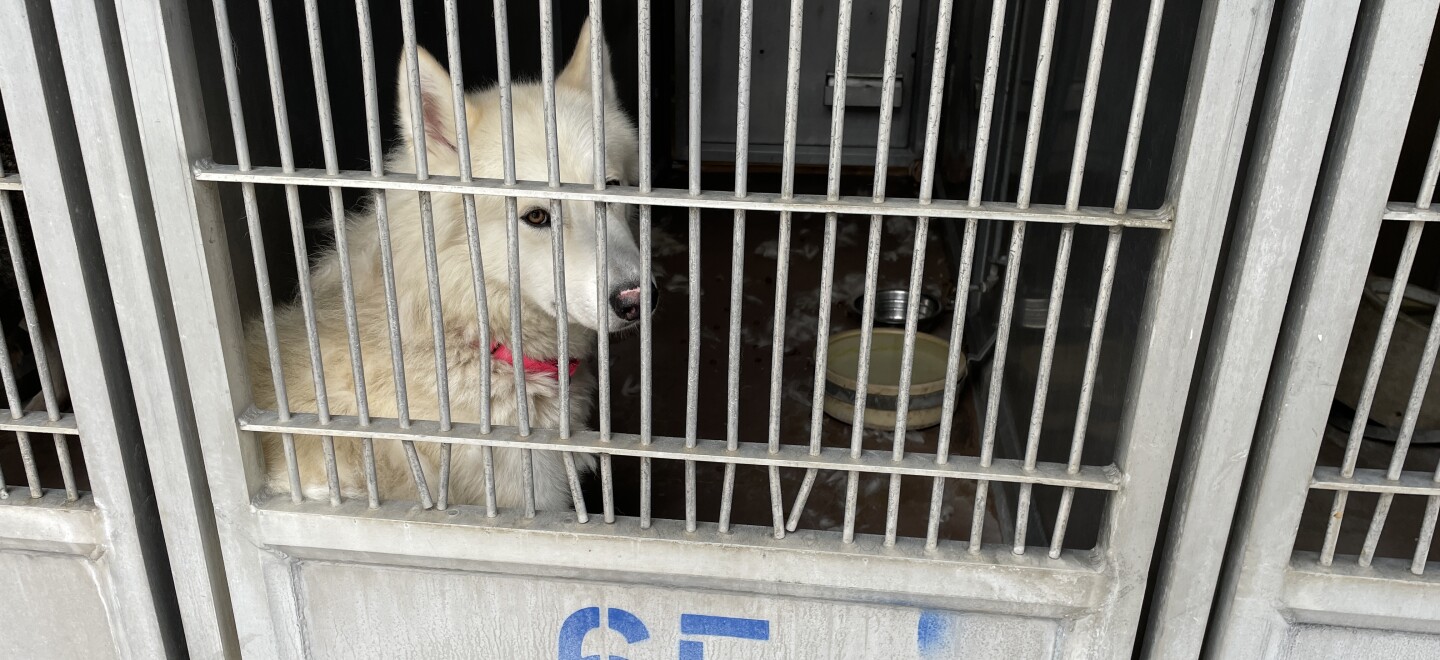In 2023, the San Diego County Department of Animal Services hired an outside consultant to audit its two animal shelters and identify areas for improvement.
The shelters in Carlsbad and Bonita serve the county’s unincorporated areas. Early on, Austin-based consultant Kristen Hassen had leadership close the Bonita facility for a day after observing serious issues.
Some of the most urgent problems involved the kennels, where dogs spend nearly all of their time. Staff were cleaning the kennels with a hose while dogs were still inside — a clear violation of industry standards. Many kennels didn’t have beds, so dogs were left to sleep on concrete floors. The dogs also lacked toys or bones to keep them occupied.
Over the next several weeks, Hassen concluded the department didn’t have the staff and resources to properly run two shelters.
She provided detailed recommendations to fix these and other problems in her audit submitted to the Department of Animal Services in early 2023.
The department kept the audit and its findings under wraps and did not share it with county leaders. KPBS independently obtained a copy — the county has not provided it in response to a public records request.
“It was buried within the department,” said a former management employee at the Department of Animal Services. They spoke to KPBS on the condition of anonymity due to fears of professional consequences. “It was like, ‘It’s our secret, and we’ll handle it internally.’”
Two years later, many of the most serious problems persist. At Bonita, kennels are still hosed down with dogs inside, and most dogs still lack beds.
Last year, the staff turnover rate was nearly 70%. In interviews with KPBS, current and former employees described chronic understaffing and a general sense of demoralization at the department.
Have a tip? 📨
The Investigations Team at KPBS holds powerful people and institutions accountable. But we can’t do it alone — we depend on tips from the public to point us in the right direction. There are two ways to contact the I-Team.
For general tips, you can send an email to investigations@kpbs.org.
If you need more security, you can send anonymous tips or share documents via our secure Signal account at 619-594-8177.
To learn more about how we use Signal and other privacy protections, click here.
“The areas of concern were significant,” said Bruce Wagman, a San Francisco-based attorney with decades of experience in animal law, after reviewing the audit. “Those things should definitely be changed.”
The problems described in the audit are not simply quality of life issues for animals in the shelter. Persistent discomfort raises stress levels for animals in kennels, which might worsen existing behavioral problems or create new ones.
The consequences can be dire.
A KPBS investigation last month found the dog euthanasia rate at county-run shelters skyrocketed since 2023. The shelters increasingly cited behavioral problems to justify putting dogs down. Behavioral euthanasias now make up the majority of dog euthanasia cases.
In an email, San Diego County spokesperson Tammy Glenn confirmed the Department of Animal Services’ previous leadership received a copy of the audit but did not share it with others in the county. She added that current department director Vaughn Maurice, who was hired last August, was unaware of the audit.
“Some initial improvements were made based on the observations of the consultant during visits to the shelters, and the department looks forward to identifying additional opportunities,” Glenn said in her email.
Glenn noted that the department’s turnover was 22% through the first six months of 2025. The county plans to replace the 50-year-old Bonita shelter with a “state of the art” shelter in Santee. The facility will offer modernized kennels and is expected to open in the summer of 2026.
Glenn’s email claimed Hassen provided the department with only a draft version of the audit.
In a text message, Hassen said she delivered a finalized version of the audit to the county. She declined to comment further on the audit’s findings.
‘Unacceptable’ conditions
Hassen’s firm, Outcomes Consulting, has worked with large municipal animal shelters around the country, including ones in Los Angeles, Dallas and San Antonio.
San Diego County paid the firm $28,000 “to conduct an in-depth evaluation to ascertain the current state of the organization and assure it is providing adequate internal and external services,” according to its contract with Outcomes Consulting.
Hassen interviewed employees and observed shelter operations. She noted a range of positives in her audit. Staff members were engaged, enthusiastic and proficient at animal care and handling. The facilities were clean and free of widespread diseases or illnesses.
The Carlsbad shelter “was well-run with humane enrichment and high care standards,” according to the audit.
But the Bonita shelter was another story. Hassen described seeing an employee tasked with cleaning nearly 100 kennels one morning.
“The staff member did not have time to clean appropriately and instead simply hosed down the kennels with water with the dogs inside,” the audit states.
The practice violates the department’s own policy manual. It’s also deemed “unacceptable” under the guidelines established by the Association of Shelter Veterinarians, meaning it “need(s) to be avoided or prevented without exception.”
In June, KPBS reporters visited the Bonita shelter and witnessed a worker spraying down dog kennels with a hose. Department staff members — one currently employed and another who recently left — confirmed to KPBS that kennels are still being cleaned with a hose while dogs are inside.

“The fact that they're still doing an ‘unacceptable’ practice, even after the audit highlighted that, it really (shows) how much they're struggling,” said Dr. Amy Fischer, a teaching professor in the Department of Animal Sciences at the University of Illinois Urbana-Champaign.
Glenn said in her email that the Bonita shelter is not set up to move dogs from one side of the kennel to the other during cleaning, like the Carlsbad shelter.
“We are actively working toward improvements in kennel cleaning practices at the Bonita shelter to better align with the Association of Shelter Veterinarians (ASV) guidelines,” she wrote, but did not provide specifics on the planned improvements.
The audit also recommended the department provide dogs with beds and chew toys for enrichment. During a recent visit to the shelter, KPBS counted 78 dogs in kennels; 63 did not have a bed. Fewer than half had toys or bones.
“It’s heartbreaking,” said Fischer. “If a dog has to be in a shelter, you want them to at least have a bed.”
In her email, Glenn said raised dog beds had been added “where kennel design allows at the Bonita shelter.” She also noted that toys are provided to dogs, though sometimes they’re removed for cleaning or not given to dogs with certain health conditions.
Additional recommendations
The audit included a number of other recommendations, but progress has been hit-or-miss.
For example, Hassen provided a 4-page workflow for handling dogs at risk of euthanasia.
It recommended appointing a department “case manager” for at-risk dogs. It also provided a detailed checklist to complete for each dog to ensure all avenues are exhausted before resorting to euthanasia. Glenn did not answer questions about the department implementing either of these recommendations.
She wrote in her email that the Department of Animal Services has an internal “Pathways Committee” that reviews dogs at risk of euthanasia.
“Each animal is considered as an individual, with all aspects of its health, history, and potential for rehabilitation considered,” Glenn wrote.

Yet KPBS previously revealed that the committee does not maintain records such as agendas or meeting notes. A KPBS analysis of more than 200 pages of medical and behavioral evaluations for euthanized dogs found no mention of the committee.
According to Glenn, the department posts dogs scheduled for euthanasia on a centrally-located board to notify staff and volunteers, a practice that is encouraged in the audit’s recommended workflow.
The audit also urged the shelter to expand its foster program, with the goal of housing 50% of its animals in foster homes. Glenn wrote that the department has expanded its animal foster program in recent years, doubling the number of volunteers to 500. Currently, about 8% of county shelter animals are in foster homes.
More broadly, the audit encouraged the department to develop a strategic plan with measurable goals on a month-by-month timeline. Glenn did not respond to a question regarding whether the department had developed a strategic plan.
Board of Supervisors unaware
Initially, leadership at the Department of Animal Services met regularly to address the audit’s recommendations, according to the department source who worked in management.
But at some point “it fell off the radar,” they said, and the department never shared the audit with other county officials.
County supervisors Joel Anderson, Terra Lawson-Remer and Jim Desmond served on the Board of Supervisors when the Department of Animal Services commissioned the audit.
“I am not aware of the Board receiving a copy of the audit in question,” said Spencer Katz, spokesperson for Lawson-Remer, in an email.
“Our office doesn’t have any records of this audit,” said Ian Harper, spokesperson for Anderson, in an email.
Neither of the spokespeople responded to requests seeking an interview with the supervisors.
Miles Himmel, a spokesperson for Desmond, declined to say whether his office received a copy of the audit.

Wagman said the audit should have been shared among county leadership in order to ensure follow through on its recommendations.
“That's terrible,” he said. “Of course it should have gone to everybody.”
At the same time, Wagman argued government-run animal shelters deserve grace and understanding, even when they fall short.
“Shelters are the dumping grounds for the animals that we as a country don't want to deal with,” he said. “They're overstressed, overpopulated, dealing with a lot of sick animals. And that's not an excuse at all, just to be clear. But it's a reality.”
Fischer echoed this sentiment. She said shelters are overburdened due to a complex web of issues. Local governments leave many shelters under-funded. Spay and neuter resources are expensive and became harder to access during the pandemic. And dropping off unwanted pets at a shelter has become the default for owners when other options should be considered.
“People are getting very upset because animals are being mistreated or euthanasia rates are going up,” she said. “People tend to blame the shelters — the shelter is just one small part of a much larger system that is failing these animals.”






